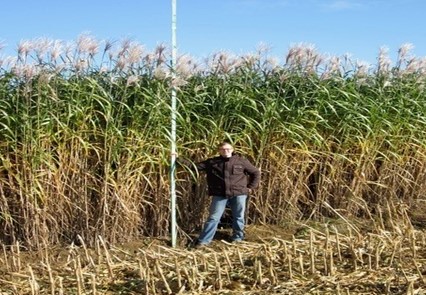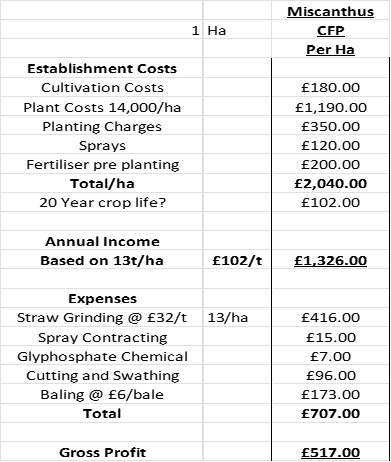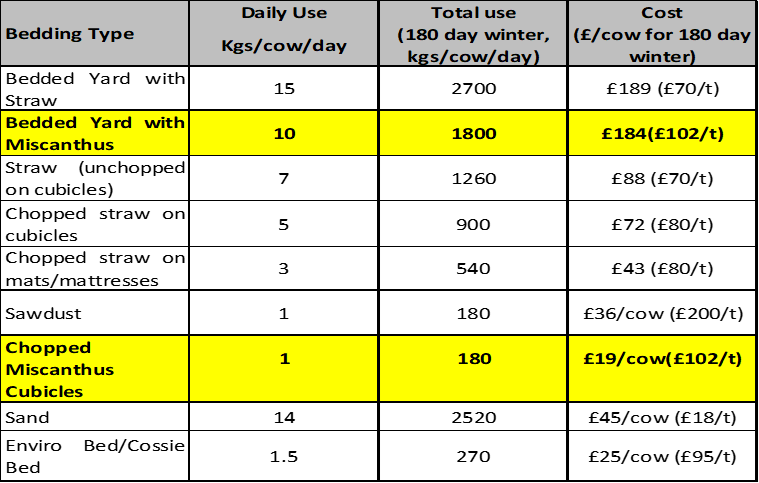Miscanthus – An Alternative Sustainable Cattle Bedding?
 Sand, Straw and Sawdust are becoming high-cost bedding materials. Straw potentially would add carbon back to the soil so chopping behind the combine could become the normal.
Sand, Straw and Sawdust are becoming high-cost bedding materials. Straw potentially would add carbon back to the soil so chopping behind the combine could become the normal.
Miscanthus also known as elephant grass, has traditionally been grown for biomass fuel for power stations around the world. The crop grows over three metres tall and produces a crop every year. With a twenty-year lifespan, very little input costs after establishment and similar characteristics to straw why cannot it be used as a bedding material either through a straw spreader or ground for cubicles beds.
 Miscanthus is a woody rhizomatous C4 grass species that resembles bamboo in physical structure. It has an annual growing cycle and is harvested once a year at its driest state in the UK - April/May. Miscanthus is a 'hands-off' crop that after initial planting does not require replanting or any fertilisers, chemicals (glyphosate could be used when conditions are not ideal) or soil cultivation making it organic. It grows rapidly, high yielding and low mineral content making it a brilliant product for both biomass and animal bedding. As a C4 plant it shows higher irradiation conversion efficiency than C3 plants (e.g., Wheat) and has a more efficient use of nitrogen and water.
Miscanthus is a woody rhizomatous C4 grass species that resembles bamboo in physical structure. It has an annual growing cycle and is harvested once a year at its driest state in the UK - April/May. Miscanthus is a 'hands-off' crop that after initial planting does not require replanting or any fertilisers, chemicals (glyphosate could be used when conditions are not ideal) or soil cultivation making it organic. It grows rapidly, high yielding and low mineral content making it a brilliant product for both biomass and animal bedding. As a C4 plant it shows higher irradiation conversion efficiency than C3 plants (e.g., Wheat) and has a more efficient use of nitrogen and water.
The Calculation to the right shows a typical cost of production per hectare making it a viable crop to grow for selling or home use.
 The Table left gives a comparison in bedding costs per cow, buying Miscanthus is still more cost effective.
The Table left gives a comparison in bedding costs per cow, buying Miscanthus is still more cost effective.
We are becoming more focused on the environment and carbon sequestration, miscanthus could benefit dairy farms, hitting Net Zero Carbon and replace higher bedding costs.
To discuss further how this may be an effective value for money bedding material for you, please contact – Mark on 07984 785190 or e-mail markyearsley@fcgagric.com
Recent Articles
- Do You Know the Benefits of a Health and Heat Detection System?
- Have you Ordered Your Silage Inoculant?
- Growing More Grass With Less Nitrogen, Where Do I start?
- A Real Recognition of The Importance of Food Security or Simply A Reconciling of DEFRA Budgets?
- Silage Sheet Prices Available!
- Are Your Cows at Risk of Grass Staggers?
- Feed Late Afternoon and Calve in Daylight Hours!
- Q Fever
- Aerating Your Soil Without A Machine? – Gerard Finnan
- Why Are You Not doing a Soil Management Plan?

